What is a 1-3-1 Zone Trap?
The 1-3-1 Zone Trap Defense is an aggressive half-court trapping defense. It is designed to constantly trap or trap in certain spots of the floor. The 1-3-1 Defense keeps players in a zone scheme so they are guarding an area of the floor. But when the ball enters certain areas of the floor then the trapping aspect of the defense makes it so two defenders are responsible for the ball. Since two players are guarding the ball, it creates natural trap areas in the half-court.
Advantages of a 1-3-1 Zone Trap
1. Aggressive
This 1-3-1 Zone is a trapping defense so by nature it is going to be an aggressive defense. The players should always be either running to a trap or running to a spot for a potential steal from a pass out of a trap. It is going to put a lot of pressure on the offense to not turn the ball over.
The aggressive defense also prevents the offense from being able to run their offense. The offense is constantly going to be getting trapped so they should not have time to setup a play. This means the offense must play without their standard structure and organization. This chaos can make the offense struggle and play faster than they would normally play. This leads us to advantage #2 of controlling the tempo.
2. Controls Tempo
I firmly believe the team that can control tempo is going to win most games. The aggressive style creates a game that is going to be fast paced. The 1-3-1 trap is going to force the offense to play quick or the offensive players are going to get trapped. This forces the game to be played at the pace the defense sets. Games are going to have a lot of shots and a lot of possessions. Scores are going to be higher.
With the tempo of the 1-3-1 trap, the defensive team must have very well conditioned players or a 9- or 10-man rotation. When done correctly, players should be getting tired quickly and need to have regular breaks during the game. If the opposing team is not conditioned well or does not have the rotation needed, then they could struggle late into the games.
3. Creates turnovers and runouts
The 1-3-1 trap defense when done correctly will force the offense into bad spots. The hope is the offense will make bad passes out of those bad spots. Those bad passes will lead to steals and steals will lead to runouts and layups. Some players do not handle pressure well and knowing they will be getting trapped all game could raise their anxiety even before the game starts.
Before the game even begins those kinds of players have no chance of having a good game. They are going to make bad passes and quick passes. They do not want the ball in their hands having to deal with the pressure the defense is putting on their team.
All of this feeds into the aggressive style the 1-3-1 trap is trying to create. The pressure defense leads to traps, which leads to bad passes, and finally leads to easy layups after those turnovers. That is the foundation for running a 1-3-1 half-court trap defense.
Disadvantages of a 1-3-1 Zone Trap
1. Gives Easy Baskets if traps do not work
The 1-3-1 trap is really aggressive but if that aggression does not create turnovers, then the offense will be getting easy shots or at least open shots. If the offense can pass through the trap, then it creates a natural 4 on 3 advantage to the offense. This should lead to the offense getting good looks.
As a coach, it is a risk-reward scenario. If your 1-3-1 trap defense creates more turnovers and bad shots than the amount of good open shots the offense gets, then you are winning. However, if the trapping defense quits working then the game can turn ugly real quick for your team. If the offense figures out how to play through the defense, then the trapping defense must be changed immediately. The problem most coaches run into is staying in the defense too long and giving the opponent a good run before finally making the change.
2. Bad Situational Defense
If the primary defense is a 1-3-1 trap, then it can cause problems with any other situation that works against this philosophy. For instance, if you are up by 3 points or less with under 2 minutes to go in the game, then as a coach, you may want to slow down just a little bit on offense to make sure you get the best shot possible. If your players are only used to playing this up-tempo style, then they may not be able to slow the game down. The ability to play different tempos can be hard for teams. And if your team is dedicated to one tempo like the 1-3-1 trap, then it forces you to play end of game situations quickly which can be difficult.
I have scouted and watched a lot of teams play an up-tempo style have a 5- or 6-point lead late into the game and lose. They continued to take quick shots and let the opponent battle their way back into the game. A lot of games may come down to one or two important possessions late in the game. This style of defense can be hard for teams to adjust their play for those hyper-focused possessions. This could also be a case where a team can change their approach into a non-trapping 1-3-1 for these possessions. This switch may be what the players need to slow down and execute at the highest level in these late in game situations.
3. Better teams can make defense chase the ball
The aggressive 1-3-1 trap can cause problems for opposing teams. However, there is a point where an opponent is good enough to constantly handle the trapping pressure. If and when this happens the offense has created a problem for the defense. The defense is going to be chasing the ball trying to trap. When a team is good enough to keep the ball ahead of the trap then the defense has nothing more to do than chase the ball. At this point the offense can get any shot they want, and the defense will struggle to stop the offense on each possession. Once this starts happening then the defense must be changed.
Positions of a 1-3-1 Zone Trap
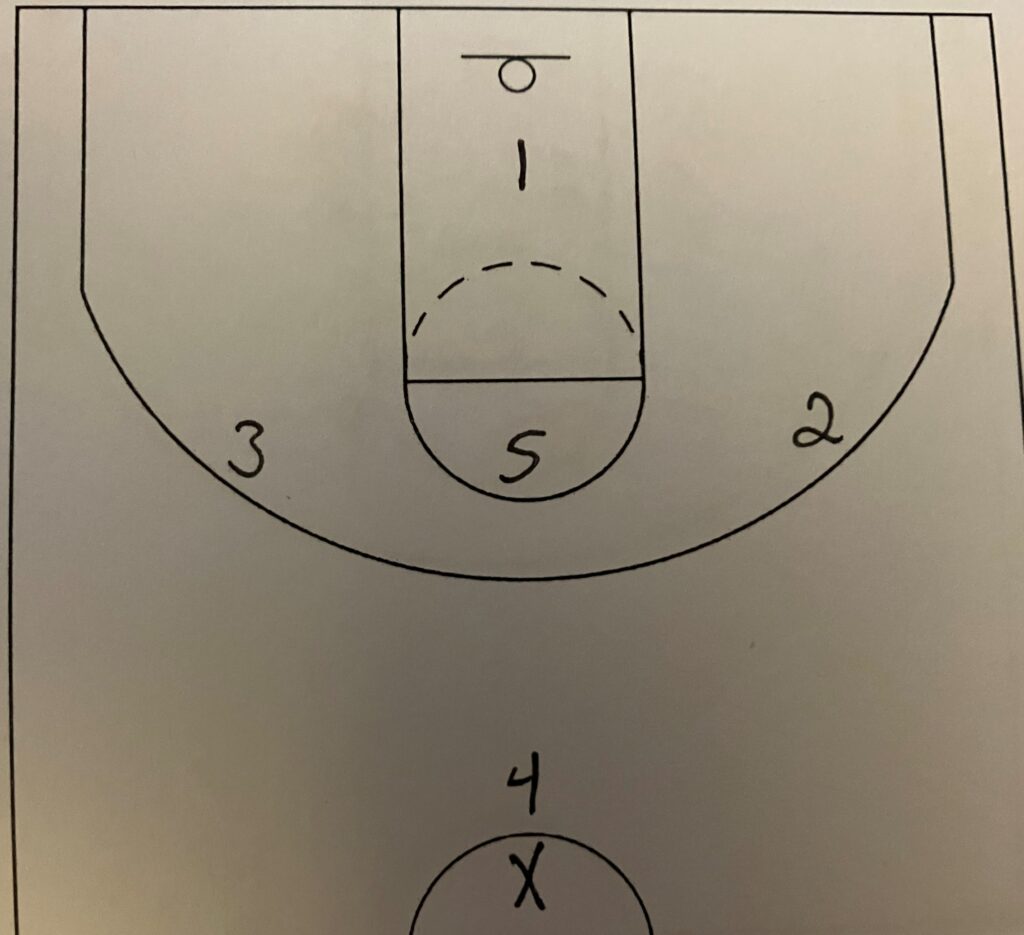
This is the initial setup of the 1-3-1 Zone. This is really the only position the offense can put the ball where there is not an immediate trap. The top man(4) has the first job of getting the ball to one side of the floor. It does not matter which side but the ball needs to stay out of the middle of the floor. Once the ball moves to one side then the trapping can begin.
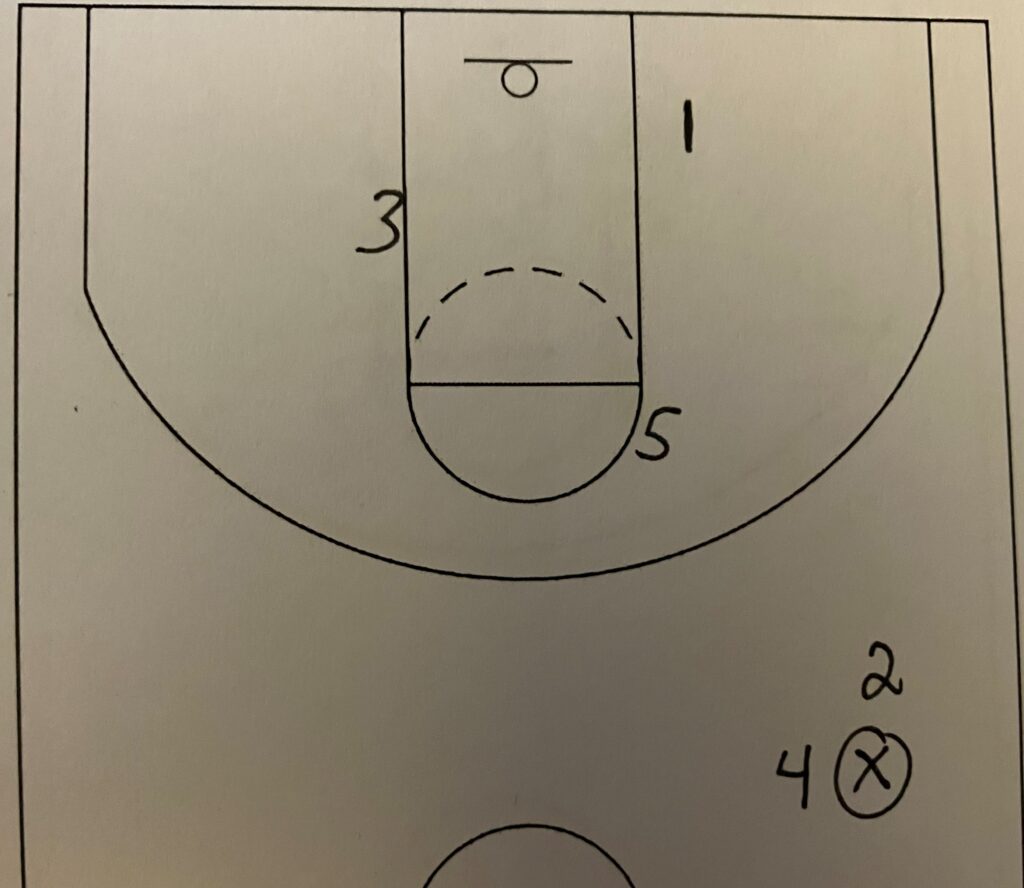
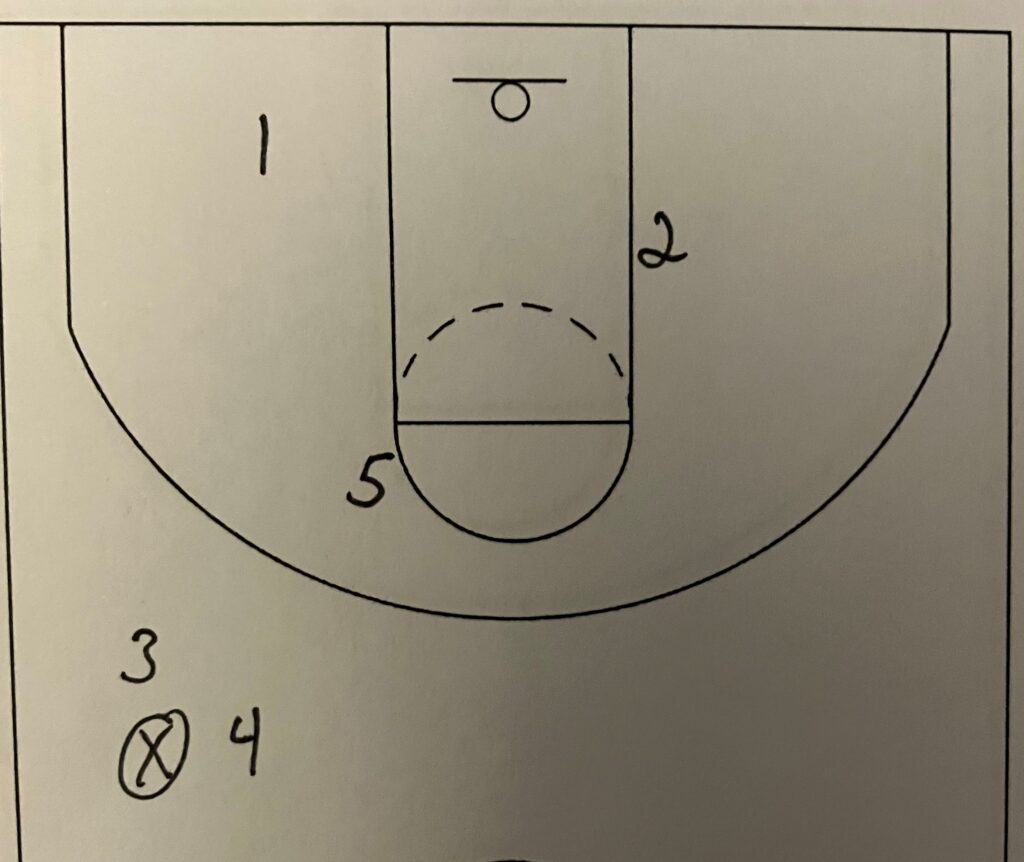
The first two trap spots is when the big(4) gets the ball to one side. The ball side wing(2 or 3) comes up to trap with the big(4). The center(5) takes away the hi post area. The point(1) is looking to steal any pass coming down the sideline towards the corner. The back side wing(2 or 3) position is going to determine how aggressive the 1-3-1 zone is going to be.
An ultra-aggressive defense is going to keep the back side wing around the 3 point line. They are going to be looking for a lob pass coming across the court to be stolen. This aggressiveness gives up the diagonal skip pass. The thought is the trap itself will prevent that long diagonal skip pass. A more conservative 1-3-1 zone will keep the back side wing somewhere close to the paint.
The trap up high wants to use the midcourt and sideline as two extra defenders. This will prevent the offensive player from being able to dribble away from the trap. I call these two spots on the floor, “dead zones.” The defense wants the ball to be in these areas because it is great places to trap. The offense wants to avoid these areas if at all possible because of the threat of the trap.
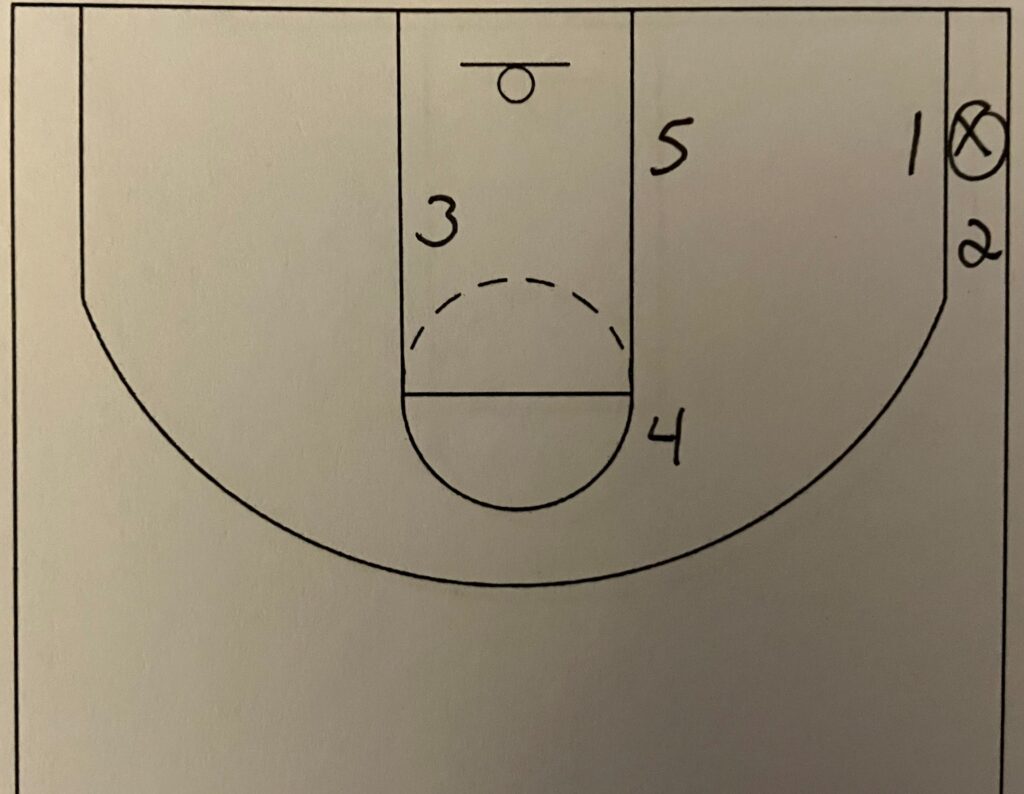
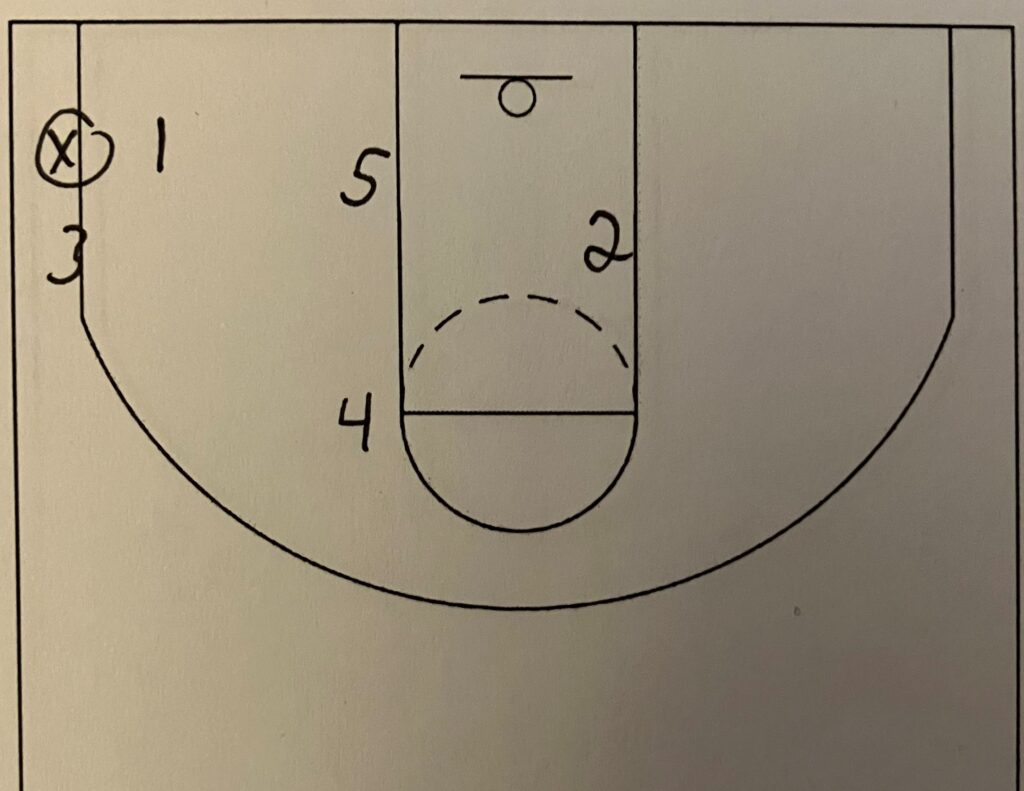
The next two trapping spots and possible better trapping spots are the two corners. The point(1) is trapping by keep the ball from going around the baseline. The wing(2 or 3) is keeping the ball in the corner by not allowing the ball to come back up the sideline. The center(5) is taking away the block. The back side wing(2 or 3) is taking away the entire backside. They are looking for any skip pass coming out of the trap for a possible steal.
The positioning of the big(4) will help to determine how aggressive the 1-3-1 zone is going to be. A conservative 1-3-1 zone will keep the big(4) in around the hi post area. A pass into the hi post can lead to a good shot by the offense. So keeping the big(4) close to the hi-post will take away the chance for the offense to make one pass out of the trap to a direct shot.
An aggressive approach to the 1-3-1 zone will have the big(4) trying to read the shoulders of the offensive player being trapped to see where the pass is going to go. This will cause the big(4) to be anywhere from the ball side sideline to the hi-post. The big(4) will try to anticipate the pass by reading the shoulders of the passer as well as where the other offensive players are located on the floor. The anticipation needed to get a steal coming out of the corner trap must give the big(4) the freedom to play without structure. This player needs to have the trust of the coach to play without repercussions in their decision making.
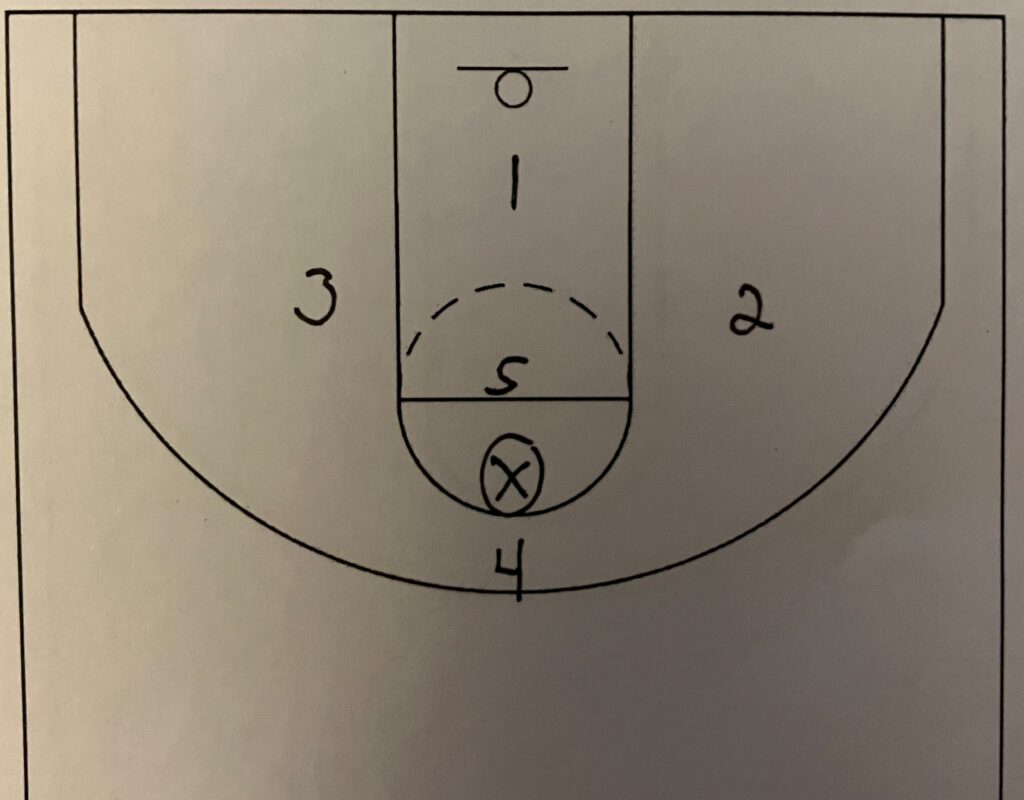
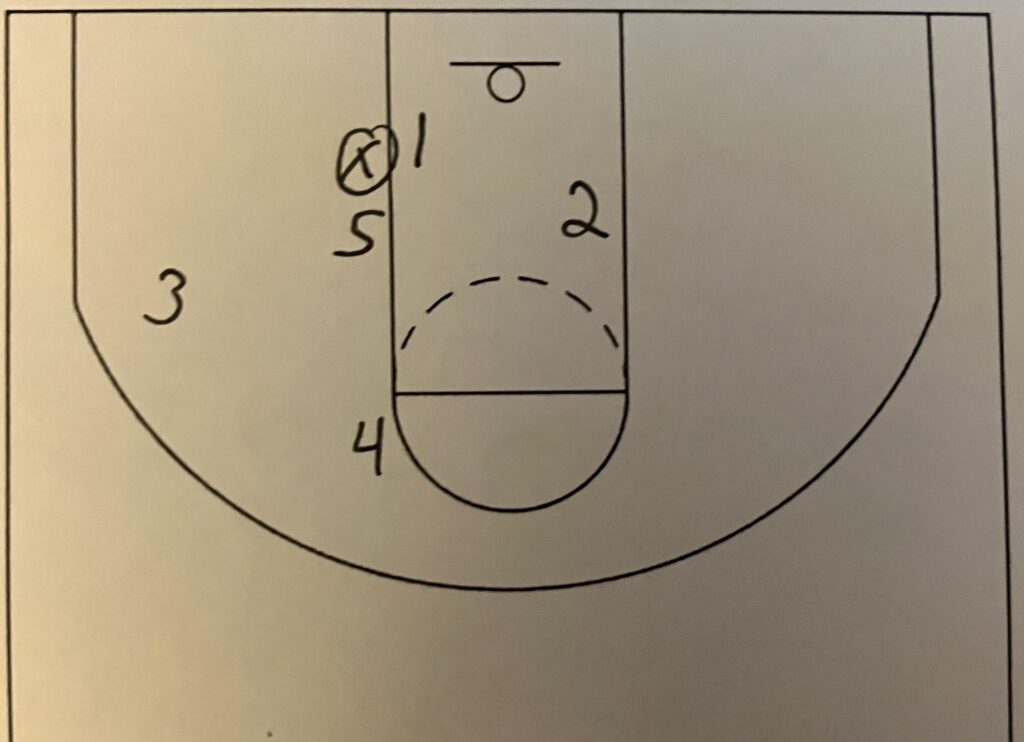
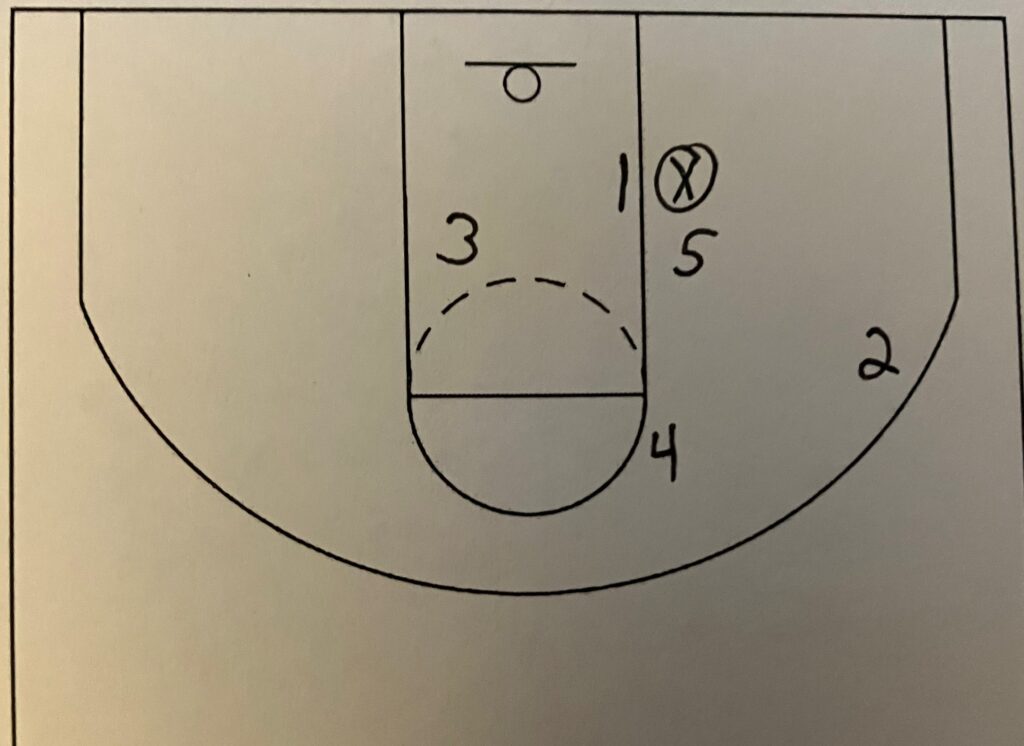
The other spots on the floor where the ball could end up is in the post areas. The offense is trying to get the ball into these spots. The defense wants to keep the ball out of these spots because it will collapse the defense. When the defense collapses, it creates space for the offense to move and attack.
If the ball enters the hi-post, the center(5) and big(4) collapse to trap the ball. The point(1) is moving block to block depending on where the offense has its players. The two wings(2 and 3) are playing the areas from the block out to the 3-point line depending on where the offense is located. The reason the defense wants the ball out of this spot is because it narrows the defense. The defense will not trap the first pass out due to the collapse. It will be the second pass after the ball is in the hi-post before the defense can trap again.
If the ball is passed to the low block or short corner, it collapses the defense but not as bad as the hi-post area. The point(1) and center(5) trap the ball. The big(4) is taking the hi-post to top of the key area. The ballside wing(2 or 3) is taking the corner or wing kick-out. The backside wing is covering the entire backside area of the floor by themselves. A backside kick-out has to be covered by this backside wing.
The ballside wing must stay off of the block area for the defense to be able to recover once the ball is passed into this low block area. If the wing collapses then it is a triple team. If the ball is passed out of it then the offense has 4 players spaced out with only 2 defenders left not in the trap. If the ball side wing can stay out to the kick-out, then the defense has most of the floor covered on the kick-out no matter where that kick-out is thrown. This area can be the cat and mouse game between the offense and defense. This area could determine the risk vs reward I talked about earlier as to which team has the advantage over the other.
Trapping in a 1-3-1 Zone Trap
The 1-3-1 trap defense is an all-out effort defense looking for traps. This defense is trying to trap the ball no matter where the ball is at. The four main spots in the two corners and the top spots near the sideline. Those are the four best spots to trap because it uses the floor as an advantage of the defense. The 1-3-1 zone uses the sidelines, baseline, and half-court line as added defenders in these 4 spots. These spots help to minimize the space the offensive player can use.
When the traps occur in the corner, the sideline and baseline create barriers to the offense. The offensive player cannot dribble away from the trap because this will put them out of bounds causing a turnover. The traps in the 1-3-1 zone put pressure on the offense and try to reduce the space the offense can use.
Personnel Needed for a 1-3-1 Zone Trap
There are two types of teams that a 1-3-1 trapping defense works really well. A team should either be really quick or really long. Since a trapping 1-3-1 zone is going to have players covering a lot of the floor, the defense needs some advantage to make the defense work.
A quick team needs to have 4 really quick players to be effective. The center(5) does not need to be quick but the other four players should be quick. That quickness allows the defense to cover more ground and should be able to get more traps in the defense. The ball can be passed between offensive players faster than defensive players can run. However, by having a bunch of quick players, this difference in speed can be minimized.
If the team is not quick, then the defense should be tall and long. Tall players can take away more passing lanes which should keep the ball in each offensive player’s hands longer. That one or two second pause can be the difference between getting a trap or chasing the ball around. The also added benefit is if two tall players are trapping a shorter player than the pass coming out of the trap should be a stealable pass. The top man and two wings can cause a bunch of problems for opposing guards if there is a significant height difference.
Keys of a 1-3-1 Zone Trap
1) Risk vs Reward
With any aggressive defense, there is a risk vs reward factor. If the trapping 1-3-1 is working, then the defense should be getting some turnovers. But by being aggressive and going for steals, if the defense does not get the steal, it could mean an easy basket for the offense. There is a tipping point when the offense is getting more easy baskets rather than turning the ball over. As a coach, you need to have an idea of where that tipping point is going into the game. During the game as the tipping point approaches it might be a better idea to switch out of the defense before reaching the tipping point.
2) Conditioning
The trapping 1-3-1 is going to make the defensive players cover a lot of ground chasing the trap. The players need to be in great shape, so they do not get tired. Once a player gets tired then they are not going to be as quick and fast. Players need to be able to run for a long period of time without getting tired.
Also, the team should be deep enough to keep a good rotation to give the defensive players a break. If the opposing team only plays 5 or 6 players, then the 1-3-1 trap can keep each player moving and possibly wear out the opposing team. This thought also goes into the risk vs reward because the risk early in the game might be really high. But once the opposing team gets tired then the reward late in the game could be that much better.
3) Rebounding
An aggressive defense can lead to turnovers, but it can also lead to quick or bad shots. Since two defenders should be close to the shooter this leaves only 3 defensive players around the basket for the rebound. The center(5) can be a huge benefit if they are able to get a bunch of rebounds. But with every possession working towards a trap, the defense is not going to have a bunch of players around the basket for rebounds. If the offense is able to get easy putbacks, then the defense can work like it should, but the benefit will not be there.
4) Deflections
The 1-3-1 trap is designed to get steals but deflections are almost just as important. Deflections while not leading to a steal can put the offense into bad spots. It is also demoralizing to the offense. After a couple of deflections, the offense will then start to change what they are doing to avoid deflections. This change in offense could be the adjustment the defense needs to go from deflections to turnovers. In an aggressive defense, deflections are an important stat to keep track of.
Youth Basketball
The 1-3-1 trap will work in most youth games. The opposing team will probably not be able to handle the pressure the trapping is going to cause. However, the trapping style is not preparing the players to increase their ability to play the game well. It could be something used more in practice for teaching how to play against the trapping zone. I do not like this defense at the youth level because it is basically just having the players run around without any thought about guarding or positioning. A practice tool to help the offense is about as far as I would want this defense to be taught.
At the high school, I like to have this defense available to use if I have the right type of team like I stated above. I like the ability to mix the trapping 1-3-1 with the non-trapping 1-3-1 and 1-3-1 Press to give the offense different looks.
Conclusion
Giving the right mix of players, the 1-3-1 trap can be an effective defense. However, I do not think the 1-3-1 zone is a good defense to use as a primary defense. A good team will eventually figure out how to score against a zone. But as a change of pace defense, I like it. If the game is moving too slow then a trapping defense can help to quicken the game pace. It is also a good choice late in the game when your team is down to try and get some turnovers to get back into the lead. Overall, the 1-3-1 zone has its uses and can be effective. However, as a coach, there has to be an understanding of when to use to maximize the ability of the 1-3-1 trapping zone defense.

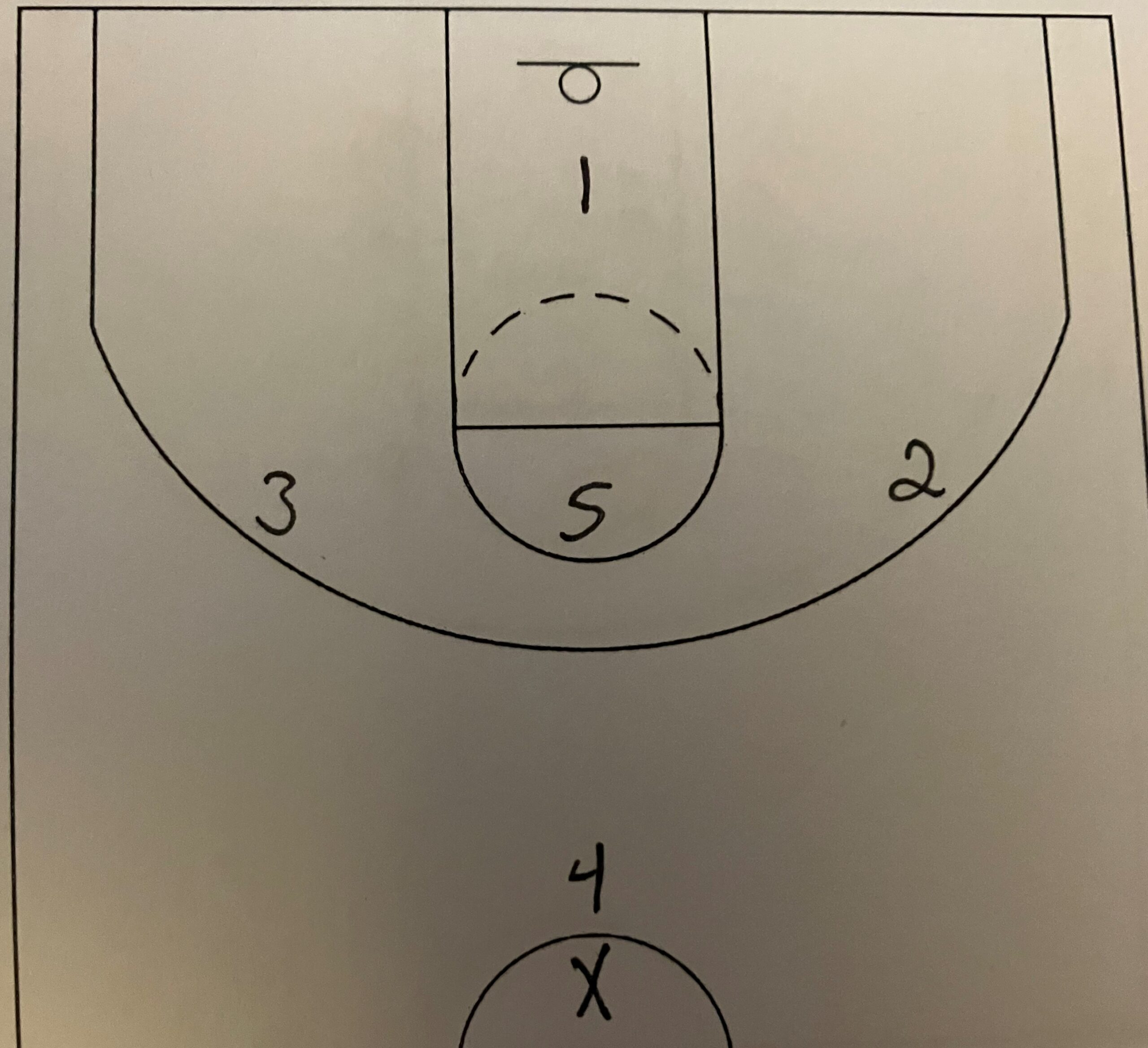
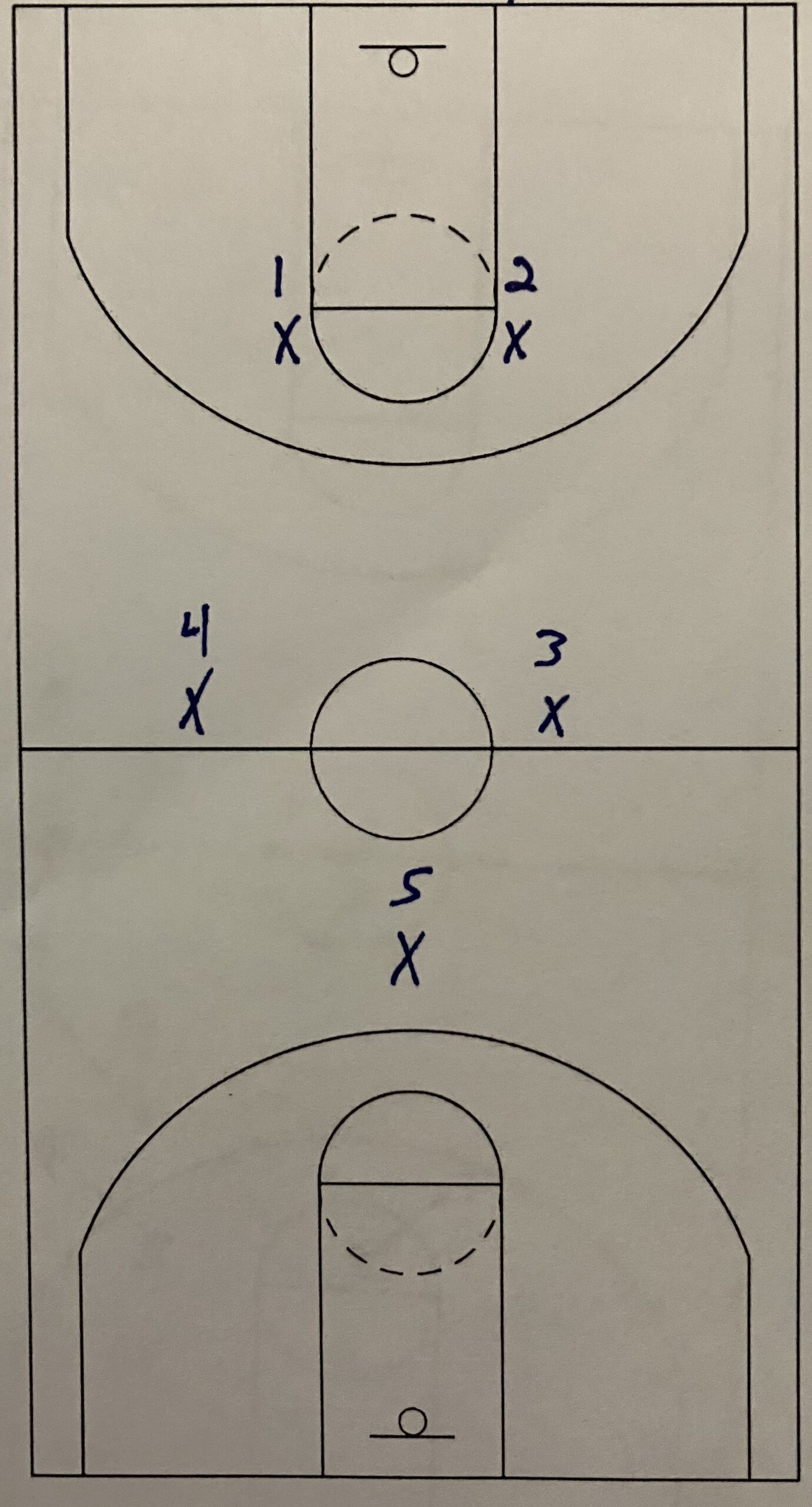
13 thoughts on “1-3-1 Zone Trap Defense Guide”